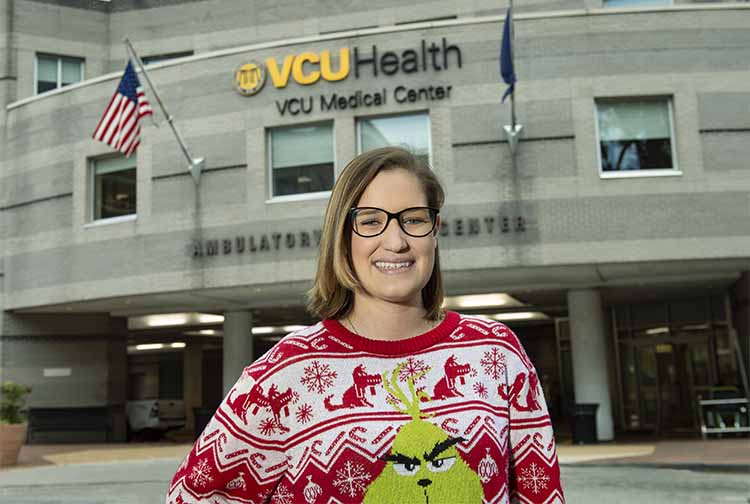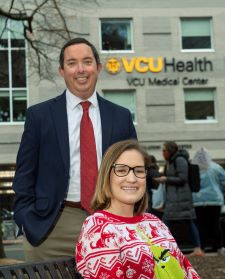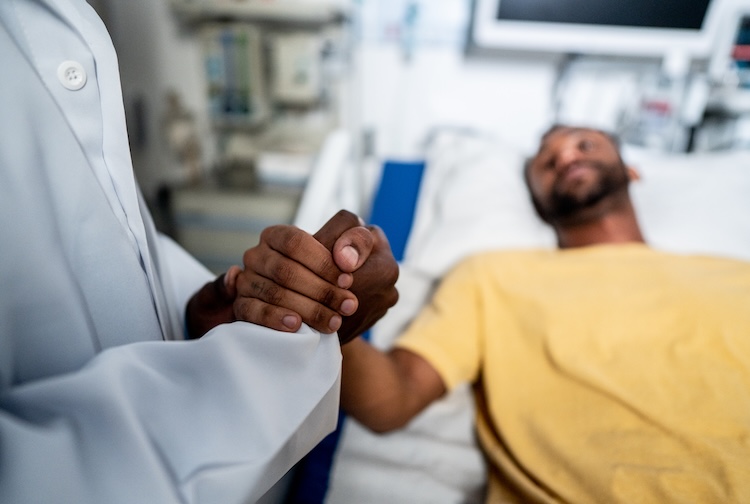
VCU Health patient is first to receive infusion in milestone study of myotonic dystrophy
Clinical trial offers new hope to those affected by this form of muscular dystrophy, a genetic condition that currently has no treatment or cure.
December 14, 2021 Jordan Payne (Photos: Kevin Morley, University Marketing)
Jordan Payne (Photos: Kevin Morley, University Marketing)
By Amber Logan
Jordan Payne knew something wasn’t right. While pitching for her softball team, her hand started locking up. It did the same thing when she tried to pick up her backpack.
Fifteen at the time, it would take Jordan another five years, a misdiagnosis of carpel tunnel, a traumatic fall down a Washington, D.C., metro escalator and genetic testing to rule out specific hereditary conditions before she got an answer as to why — myotonic dystrophy type 1, generally referred to as DM1.
Myotonic dystrophy is a form of muscular dystrophy that can cause muscle weakness and deterioration as well as affect many other organ systems, leading to heart, breathing and digestive problems, among other issues.
The word “myotonic” comes from the word “myotonia,” a medical term describing the inability to relax muscles at will — a common symptom of the disease.
Payne herself experiences chronic pain, fatigue and excessive daytime sleepiness, which can cause her to sleep 23 hours straight.
“When I received the diagnosis, it wasn't like a giant anvil being dropped on me. It was more like the anvil being lifted off my shoulders,” said Payne, now 22. “No one wants anything to be wrong with them, especially something like this. But to finally hear: ‘Yes, there is something wrong. There is a reason this is happening,’ was a huge relief. I didn’t feel crazy anymore. I didn't feel like I was making something up.”
No treatment or cure
But the relief of finally having a cause for her symptoms was short-lived. Like the approximately 140,000 other people living with DM1 in the United States, Payne soon learned there was no treatment or cure for this progressive disorder.
“After I got diagnosed, it was very disheartening to hear there was no treatment or cure. It almost felt like you're just given the diagnosis and sent on your way,” Payne said. “You're thinking: ‘Wait, there's nothing I can do?’ You just feel very hopeless because you know there's something wrong with you, and you can't do anything about it.”
At the advice of a family friend, Payne, who is set to graduate with a degree in sociology from Christopher Newport University this spring, came home to Richmond, Va., to consult with VCU Health neurologist Dr. Nicholas Johnson — one of the nation’s foremost researchers in genetic muscle disorders.
VCU offers hope

“Prior to being able to participate in exciting treatment trials, we first needed to understand exactly how to measure the disease for progression,” said Johnson, who serves as the co-primary investigator for the international Establishing Biomarkers and Clinical Endpoints in Myotonic Dystrophy Type 1 (END-DM1) study. Without being able to identify or measure changes caused by a disease over time, researchers can’t establish the effects of a potential treatment — the purpose of conducting a clinical trial.
Because of this foundational work and the pharmaceutical‒academic partnerships that have come out of the END-DM1 study, Johnson is now leading a phase 1/2 clinical trial sponsored by Avidity Biosciences, called the MARINATM trial, that will enroll 44 adults with DM1, ages 18-65, to evaluate the safety and tolerability of a new, first-of-its-kind experimental treatment for DM1.
“This is the first trial of a potentially disease-modifying treatment for DM1 in at least the last six years, and the first time this new class of drugs has been given to patients,” Johnson said. “We are excited that VCU is one of the eight centers in the United States participating in this study, and that we were the first site to administer an infusion.”
The start of this trial demonstrates the promise of translating research from bench to bedside, according to Peter F. Buckley, dean of the VCU School of Medicine.
“It is fitting that the first patient to receive an infusion as part of this clinical trial came from VCU,” Buckley said. “For years, Dr. Johnson has been leading the way to better understand the progression of DM1 and develop the clinical trial tools necessary to test new treatments and evaluate their safety and effectiveness for the FDA and other regulatory agencies. We are extremely proud to see this foundational research now being translated into studies that could one day provide tangible improvements in patients’ lives.”
Targeting the cause, not just the symptoms
The new treatment being tested in the MARINA trial was designed to address the underlying cause of DM1 — changes in the DMPK gene. Like most genes, DMPK contains genetic blueprints that tell cells how to make a specific protein. When these blueprints are “read,” the instructions, which are “written” in DNA, are copied into an RNA molecule (called messenger RNA or mRNA) and transported to the cell’s protein-making machinery.
People with DM1 have extra repetitions in the DNA of their DMPK gene, which causes abnormally long mRNA to be produced. These extra-long mRNA strands interfere with other components in the cell, and this interference leads to the symptoms people with DM1 experience.
The treatment being investigated in the MARINA trial specifically targets DMPK mRNA so it can be destroyed and cleared before it causes issues.
On becoming ‘the first’
In late October in VCU Health’s North Hospital, Payne became the first person to get an infusion as part of the MARINA trial.
“I had no idea I was going to be the first person to receive an infusion,” Payne said. “I know it definitely made my parents a little bit more anxious and apprehensive. They had a lot of questions, but I was more relaxed about it.”
In the week leading up to the infusion, Payne went to the clinic every day to complete the preliminary tests for the study, including blood and other physical tests to “make sure everything was in order.”
When the day finally arrived, “the infusion itself only lasted 30, 45 minutes – very fast and furious,” according to Payne. She then had to stay in the hospital overnight for observation.
“Dr. Kazi Ullah [senior clinical research coordinator in the Muscular Dystrophy Translational Research Program] stayed up the whole night sitting outside my room and helped put me at ease. He's been an amazing, amazing person throughout this,” said Payne, who reports that she felt no discomfort during the infusion and has experienced no adverse reactions so far.
Payne will continue to have follow-up appointments to monitor her health for the next six months. However, because MARINA is a double-blind study, she won’t know for some time whether she received the new treatment or a placebo. Still, she sees her participation as something bigger than herself.
“I feel very fortunate to be in this study. Not many people have this opportunity,” Payne said. “And if by me taking part, if that's going to help possibly bring about a treatment or cure, then a hundred percent I'm down for it. Because it's bigger than me. It's about this whole community of people who need a sign of hope.”



